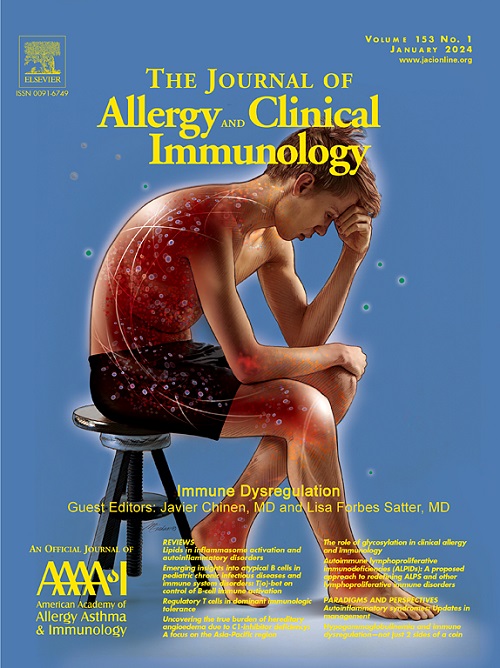在非甾体抗炎药加重的呼吸系统疾病中,载脂蛋白E的丢失有助于炎性巨噬细胞活化和铁凋亡。
IF 11.2
1区 医学
Q1 ALLERGY
引用次数: 0
摘要
nsaid加重呼吸系统疾病(N-ERD)以慢性哮喘、鼻息肉病和对非甾体抗炎药不耐受为特征。我们最近描述了N-ERD中异常的巨噬细胞激活和脂质代谢,然而N-ERD中鼻部炎症的局部驱动因素尚不完全清楚。目的研究N-ERD鼻黏膜载脂蛋白E缺乏对巨噬细胞和上皮细胞的串扰和炎症活化的影响。方法结合N-ERD患者样本和人原代细胞培养的转录和中介分析,研究ApoE在上皮细胞和髓细胞中的表达。结果与健康的鼻黏膜相比,tsn - erd鼻刮痕显示APOE表达降低,但APOE在上皮细胞中固有地低。相反,骨髓细胞表达高度丰富的APOE,在N-ERD患者的单核细胞来源的巨噬细胞中,APOE表达减少。单核细胞来源的巨噬细胞中sirna介导的APOE下调导致CXCL7表达增加,CXCL7是一种与N-ERD有关的炎症趋化因子。此外,高度氧化的花生四烯酰磷脂酰乙醇胺在ApoE敲除的巨噬细胞中积累,ApoE保护巨噬细胞免于铁致细胞死亡。结论髓系ApoE参与了2型气道炎症中巨噬细胞与上皮细胞间的串扰以及铁吊的调节。因此,ApoE缺乏可能导致N-ERD的慢性2型炎症,其恢复可以帮助重建正常的上皮屏障完整性和巨噬细胞效应功能。本文章由计算机程序翻译,如有差异,请以英文原文为准。

Loss of apolipoprotein E contributes to inflammatory macrophage activation and ferroptosis in NSAID-exacerbated respiratory disease
Background
Nonsteroidal anti-inflammatory drug–exacerbated respiratory disease (N-ERD) is characterized by chronic asthma, nasal polyposis, and intolerance of nonsteroidal anti-inflammatory drugs. We recently described aberrant macrophage activation and lipid metabolism in N-ERD; however, local drivers of nasal inflammation in N-ERD are incompletely understood.
Objective
Our aim was to study how apolipoprotein E (ApoE) deficiency in the N-ERD nasal mucosa affects the cross talk and inflammatory activation of macrophages and epithelial cells.
Methods
We combined transcriptional and mediator analysis of samples from patients with N-ERD and primary human cell culture to study ApoE in epithelial and myeloid cells.
Results
Nasal scrapings from patients with N-ERD exhibited decreased APOE expression compared with that exhibited by nasal mucosa of healthy individuals, but APOE was inherently low in epithelial cells. Instead, myeloid cells expressed highly abundant APOE, which was reduced in monocyte-derived macrophages from patients with N-ERD. Small interfering RNA–mediated knockdown of APOE in monocyte-derived macrophages resulted in increased expression of CXCL7, an inflammatory chemokine implicated in N-ERD. In addition, highly oxidized arachidonyl-phosphatidylethanolamine accumulated in APOE-knockdown macrophages, and ApoE protected macrophages from ferroptotic cell death.
Conclusion
Our results suggest a role for myeloid ApoE in regulating the cross talk between macrophages and epithelial cells, as well as in ferroptosis during type 2 airway inflammation. ApoE deficiency may thus contribute to chronic type 2 inflammation in patients with N-ERD, and its restoration could help reestablish normal epithelial barrier integrity and macrophage effector functions.
求助全文
通过发布文献求助,成功后即可免费获取论文全文。
去求助
来源期刊
CiteScore
25.90
自引率
7.70%
发文量
1302
审稿时长
38 days
期刊介绍:
The Journal of Allergy and Clinical Immunology is a prestigious publication that features groundbreaking research in the fields of Allergy, Asthma, and Immunology. This influential journal publishes high-impact research papers that explore various topics, including asthma, food allergy, allergic rhinitis, atopic dermatitis, primary immune deficiencies, occupational and environmental allergy, and other allergic and immunologic diseases. The articles not only report on clinical trials and mechanistic studies but also provide insights into novel therapies, underlying mechanisms, and important discoveries that contribute to our understanding of these diseases. By sharing this valuable information, the journal aims to enhance the diagnosis and management of patients in the future.

 求助内容:
求助内容: 应助结果提醒方式:
应助结果提醒方式:


